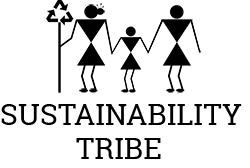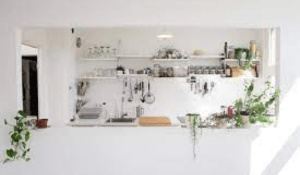Hi Tribe, it’s been more than 11 years now that I have been sharing my tried and tested sustainable lifestyle tips on Sustainability Tribe. Being sustainability consultants professionally, I and my husband give attention to many details to make our home more sustainable. For example, improving the indoor air quality of our home and detoxing the indoor air.
But let me confess, it’s only when I got pregnant 8 years back, I started giving more attention to the toxicity level in my kitchen. Like all first-time mums, I started reading many books and learned that brain development starts technically from 3rd week of pregnancy and the development rate is fastest from pregnancy until 5 years of age of the child. Early brain development has lasting impacts on a child’s ability and performance not just in school but for their entire life. Toxins have very negative impacts on a developing brain, along with other negative effects. Therefore, I studied materials used in an average kitchen and their adverse effects on health. I also learned that not just babies, we all get negatively affected by this kind of toxicity exposure at home. The more I learned about the adverse effects and hidden exposure to toxins, the more I realized the need for replacing them and finding not just sustainable but healthy & non-toxic options for my kitchen.

When we think of a healthy and clean lifestyle, we mainly focus on healthy food. I will highly recommend you to read our article ‘Understanding social and environmental aspect of food‘ on Sustainability Tribe. You can also read our Sustainable Eating Guide here. But let me tell you, it’s not enough to pay attention only to what you eat but it’s equally important to focus on what cookware, serving wear, cleaning products you use in your kitchen. So let’s go deeper into our kitchen and make it a healthy place to prepare our food!
Here I am summing up some of my tried and tested ways to make your kitchen healthy and toxic-free!
1. Cookware
Many people use aluminum cookware as it’s lightweight and inexpensive but aluminum is a reactive metal and leaches into your food. Diseases Alzheimer’s are linked with aluminum exposure. When cooking vegetables in aluminum the reaction may produce hydroxide poison which can cause gastrointestinal trouble, such as stomach ulcers and colitis.
The same goes for non-stick coated or Teflon coated cookware, what is more, dangerous that these coatings can be present directly in your food through scratches, chipping, flaking and that is the reason the coating goes away. A chemical, C-8, used to make non-stick coated pans has been linked to birth defects in humans to cancer in laboratory animals. The chemical can also be present in the blood for up to 4 years and can show up in breast milk.
There are some better alternatives, however, you need to follow some cleaning and treatment procedures to safely use these alternatives. Cast Iron is the most porous material and grease can turn into rancid in those pores, so seasoning is important. As with beautiful copper or brass cookware, you need to keep in mind that they are very reactive metals, so avoid cooking acidic food. This is the reason why copper wares are generally lined inside with another metal such as stainless steel to prevent toxic amounts of copper from leaching into foods. Also, you need to follow special cleaning and extra care for copperware and brassware. So if using cast iron, brass, or copper cookware read the instructions carefully.
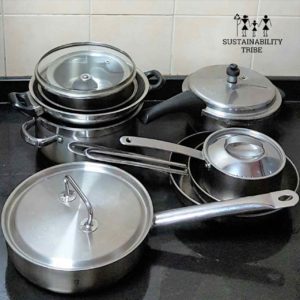
So once you ditch aluminum, nonstick cookwares you have the option of using cast iron or copper wares with special care or the safest materials are stainless steel and clay pots. Clay pots are great for even heat distribution but don’t forget to season a newly bought clay pot before starting using it for cooking. As for stainless steel, my preferred metal for cooking, you need to be sure to buy high-grade stainless steel else the low-quality one can bleed nickel into the food.
I have bought a few good quality pots and pans from Zwilling and also from Prestige and Hawkins. The pressure cooker is a staple in an Indian kitchen, great for steaming but make sure to find stainless steel! Stainless Steel cookwares are expensive but they can last long for a few generations. I proudly use some old stainless steel cookware passed on from my mother-in-law.
2. Cooking Utensils
The best cooking utensils are stainless steel or wooden. For wooden utensils, to eliminate bacteria formation, just make sure to wash them with soap and hot water after cooking.
The best thing is when you are using stainless steel cookware you can safely use stainless steel utensils, without worrying about scratching coating of non-stick, etc.
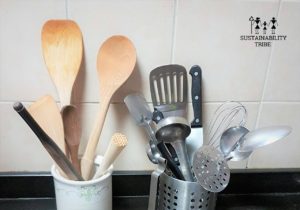
Also make sure to avoid plastic spatulas, nonstick utensils. I also avoid using silicone utensils, read my comment about silicon in the Baking section below.
3. Baking
For baking, it’s better to avoid aluminum and Teflon and we already discussed why? but the widely popular silicone bake wares are safe? Especially they are marketed as greener options, just because you generate paper waste by using these reusable silicone wears. But unfortunately, there is not enough research done on the safety of silicone. It might be nonreactive with food, but it’s difficult to find researches that might have been done to see is there any reaction silicone produces with food under heat. Also, there are concerns about chemical leaching because of the bright colors of these silicon wares. And remember, the cheaper silicone wares will be the lower quality with coatings containing fillers that may be hazardous.
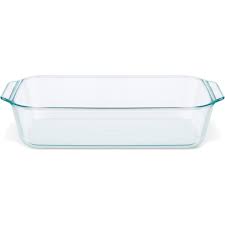
But then what are safer options? For baking, Stainless Steel and baking glass are the safest. The best is to read the manufacturer’s instructions for baking glass to avoid any kind of breakage or accidents. Incidences like keeping glass bake wear from the fridge directly into the oven can cause thermal shock and lead to breakage.
4. Food Serving
Now just choosing the right cookware is not enough, it’s also important to choose nontoxic serving sets. Melamine or plastics (even BPA free) are definitely NOT good options as with prolong use, the toxins leach into food. The best options are stainless steel or glass or ceramic. However, for glass dinner sets or ceramic dinnerware, remember to choose without much design and paints. Because more the design or color, there are more chances of toxin exposure like lead in paint.
Alternately, the traditional earthen tableware or serving ware is made from natural materials like coconut shells or bamboo, or sustainable wood.
5. Food Storage
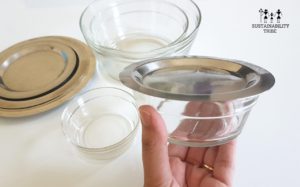
For food storage, it’s good to invest in good quality glass or steel boxes, glass, or steel bottles. Even though plastics are convenient, we know that plastic is recyclable only a few times and the microplastic leaches in food. Read more about why plastic is so harmful? So to make your kitchen non-toxic and plastic-free, you also need to ditch plastic cling film. The beeswax wraps or clothes wraps are great alternatives to wasteful and toxic plastic cling films, plastic boxes. But I prefer even a more permanent, entirely zero-waste, and traditional solution. Stainless steel lids in different sizes are passed down to me. Once you have this set of lids, they can fit on any container glass or steel bowl and I can easily store food in the fridge in a stackable manner.
Another great option to store vegetables in the fridge is cloth bags and napkins.
6. Chopping Boards
This is a bit unusual, but we don’t use cutting boards or chopping boards at home. I tried using many different types of chopping boards, wooden, plastic ones HDPE, or PE. But they are all wasteful and they become a place for bacteria to flourish. So instead, we have dedicated a few stainless steel plates for chopping and cutting. Now apart from a few light scratches, we don’t need to deal with special cleaning and care plus its entire zero waste and plastic-free option.
7. Cleaning and Dishwashing
Another way toxins enter your kitchen is through your cleaning products. That might sound like a paradox but there are a lot of concentrated chemicals, artificial perfumes added in the store-bought cleaning products. These products leave toxin residues on our plates and kitchen utensils. The cleaning products also emit VOCs (volatile organic compounds) in the air and reduce the indoor air quality of our homes. So what’s the solution? It’s either in your kitchen or waste bin!
You can create your own natural cleaning products out of food waste or pantry items. With just a few ingredients like lemon, citrus peel, baking soda, vinegar, etc, you can create your own natural cleaning products. Read this post on a step-by-step method to use lemon peels for deep cleaning the oven, microwave, and also create a natural potpourri.
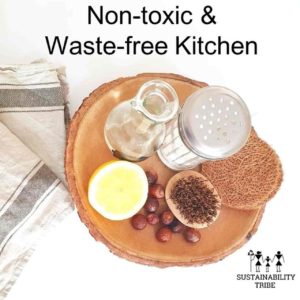
For dishwashing and floor mopping, you can create your own bio enzyme along with soapnuts. You can also use baking soda and vinegar to clean the steel kitchen sink or unclog the sink. Just remember you have to mix both, right at the time of cleaning to make use of a fizzy reaction of mixing baking soda and vinegar. To clean your fridge try spraying a mixture of vinegar and water and then wipe clean the surfaces. For deep cleaning my stainless steel cookware or even sink I prefer using boiling water once in a while.
Another important item in the kitchen is cleaning-scrubs for dishwashing. If you are using a dishwashing sponge, you should know it not just create waste but also a breeding place for bacteria. The better alternatives are metal or palm scrub, which after use you can compost.
8. Kitchen Napkins
This is another zero waste win we have in our kitchen, we use only cotton dishcloths or kitchen towels instead of paper or any other kind. The same goes for dinner napkins, we have sets for us and extra sets for our guests. Washing these kitchen napkins and clothes and reusing them, again and again, is much better than wasting huge amounts of paper napkins.
By opting for reusable kitchen towels our family saving 3000 paper napkins going to landfill annually for the last 6 years, which’s a total of 18,000 paper napkins. I haven’t calculated how many trees are we saving from cutting down. But this is just to point out how our small positive actions can create a significant impact.
9. Party Essentials
I have written an entire post about how to have celebrations more earth-friendly. But would like to repeat here that ditch the single-use plastic items if you are hosting a party at home. It’s better to employ some part-time domestic help to give you hand with cleaning after the party, that way you give one-off employment to someone. But if it’s not possible then at least invest in some sustainable alternatives like palm leaf plates-bowls, wooden cutlery. This way you serve food to your guests in toxic-free serving plates and don’t create more plastic pollution.
10. Cooking Vent
Cooking creates fumes, smoke, VOCs, odors, and affects your indoor air quality. So if you don’t have a properly working cooking vent or exhaust fan, install it. If you already have it, then don’t forget to switch it on when cooking.
On a final note, I’ll say, grow some fresh herbs in your home or kitchen which can also be used in cooking, and do not forget to install a composting unit to make soil out of your kitchen waste. While making your home non-toxic and eco-friendly, make sure your kitchen waste is not contributing to greenhouse gases when decomposing in landfills.
Inspired enough to make your home more sustainable?
You can also access our self-paced online course, Sustainable Home Masterclass. is designed to give attendees a complete guide to sustainable homes right from how to select a property up to what changes can you make in your existing property including budget-friendly options. This course will also contain an introduction to green buildings and sustainable material choices. Plus how to develop conscious consumption choices to select sustainable household items and develop simple habits for a healthy home. After this course, you will be able to gain enough knowledge to reduce your utility bills and cost elsewhere, improve your family’s wellness as well as contribute to climate action right from your home.
